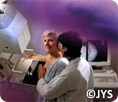
Mammography is the core test in breast cancer detection and diagnosis.
But mammograms can be diagnostic or screening.
In general diagnostic mammograms take longer to perform as they use more x-rays than screening mammograms in order to obtain some views of the breast from different angles. The radiologist may need to magnify a suspicious area.
Normally your doctor refers you for a mammogram: thiswill be because either the doctor or the patient has detected something abnormal (a lump, some nipple discharge, or a retracted nipple…) or because the mammogram is a scheduled routine test (cf. breast cancer detection)
Sometimes you may also receive an invitation to participate in a screening campaign that begins (in France) after the age of 50.
In the absence of any breast cancer risk factors, France recommends that women receive a mammogram every 2 years between the age of 50 and 74. For those women who have previously experienced cancer, or if their family has a history of cancer, or if there is an identified or suspected genetic mutation (especially BRCA 1 & 2) then it is advisable to have a mammogram every year, and often from the age of 40. Please see: patients with a genetic cancer risk and an MRI scan.


